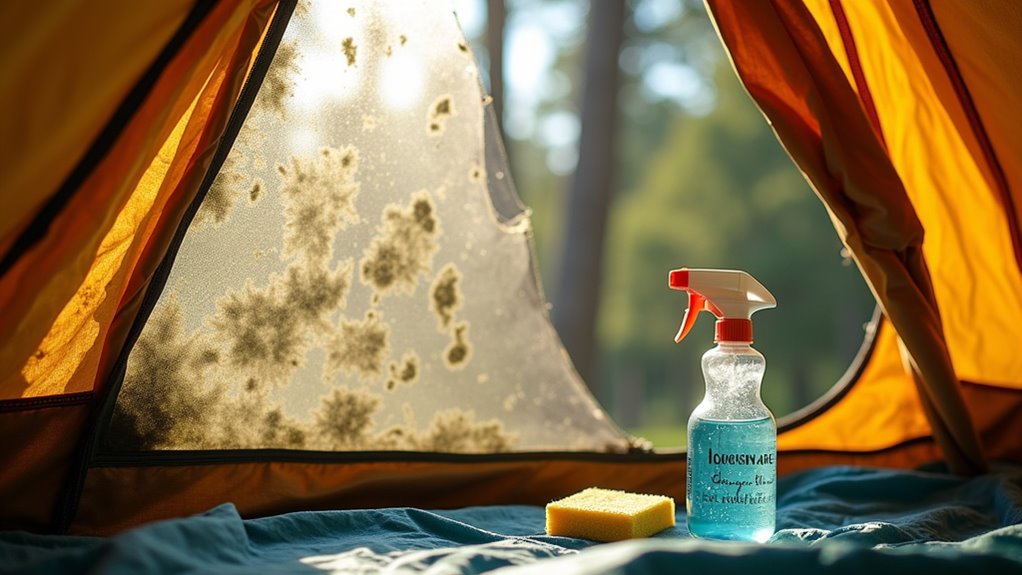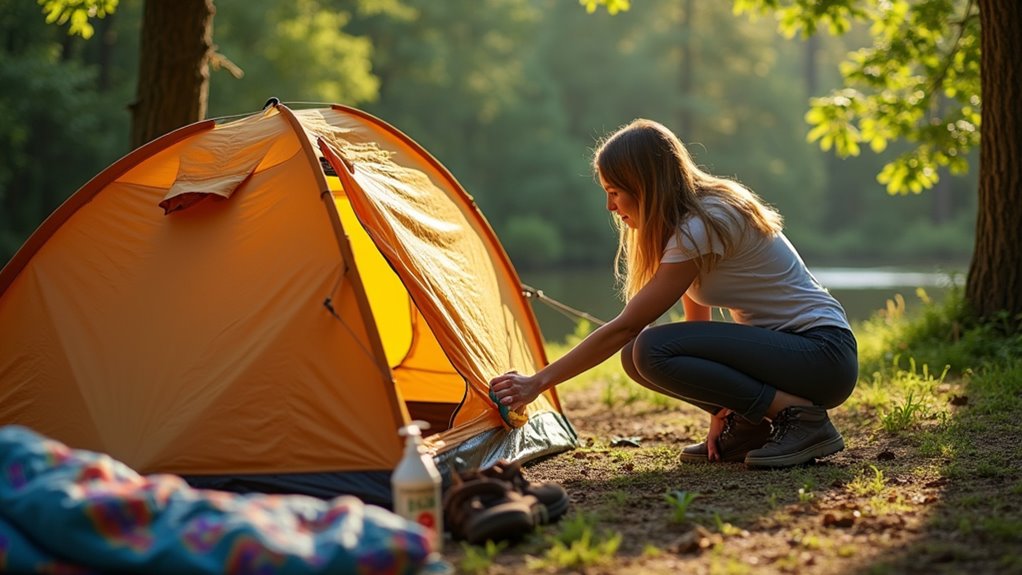How To Clean A Musty Tent
This post contains affiliate links. As an Amazon Associate, we earn from qualifying purchases.
To clean a musty tent, begin by inspecting it for mold or mildew, then use an enzymatic cleaner like MiraZyme™ or a vinegar-water solution to remove odors and prevent further growth. Gently scrub any stains with a sponge and mild soap, rinse thoroughly, and dry the tent completely in a well-ventilated area before storing it. Further details on effective cleaning methods and ongoing tent maintenance will be provided below for those interested in a more comprehensive guide.
Essential Facts in 30 Seconds
- Check the tent for mold, mildew, and damage before cleaning.
- Clean stains and musty spots with lukewarm water and mild soap.
- Use a specialized tent cleaner for deep cleaning if needed.
- Rinse thoroughly and dry completely before storing.
- Store the tent in a cool, dry place and inspect regularly to avoid mustiness.
Identifying Mold and Mildew in Your Tent

Mold and mildew on your tent can cause damage and bad smells.
Mold appears as fuzzy, colored patches. These patches may be green, black, or white. Mold often looks like dark circles on light fabric. Cleaning tent mold promptly can prevent further deterioration of the material.
Mildew looks different. It shows as powdery, gray, or white spots. These spots can feel thick or soft. A strong musty smell usually means mold is present. Mildew gives off a lighter, musky scent. Moldy areas often feel damp compared to clean fabric.
Act fast when you see these signs. Cleaning early keeps your tent safe and fresh. This helps you enjoy camping without problems. Regular maintenance ensures you can prevent future mold growth and extend the life of your tent.
Effective Cleaning Solutions for Musty Tents
Dealing with a musty tent needs the right cleaning solution. Use special cleaners or natural remedies. Here are some good choices:
- Enzymatic cleaners like MiraZyme™ kill odors and protect waterproof layers.
- Vinegar mixed with water fights musty smells and stops mildew.
- Revivex Pro Cleaner removes mold but keeps water repellency.
- Lemon juice and salt help clean visible mildew and reduce bad smells.
Start with mild dish soap and warm water. Avoid scrubbing hard on coated fabrics. Cleaning the tent in a well-ventilated area is essential to prevent mildew and ensures effective drying. Additionally, make sure to rinse thoroughly to remove all soap residue for optimal results.
Always dry your tent outside in fresh air. This stops musty smells from returning.
Pick the right cleaner to keep your tent fresh and ready for your next trip.
Step-by-Step Cleaning Procedure

Clean a musty tent with care to keep its fabric safe. First, gather lukewarm water, mild soap without fragrance, a sponge, soft brush, and a large tub.
Check the tent for tears or holes. Shake it well to remove loose dirt. Set it up if you want to clean inside.
Use a damp sponge and soap to scrub stains gently. Focus on areas like doorways and handles. Rinse with clean water. Dry these spots with a soft cloth.
For a deep clean, fill the tub with lukewarm water. Add a cleaner made for tents or outdoor gear. Soak the tent fully. Move it gently to wash all parts. To prevent future mold growth, ensure the tent is completely dry before packing it away.
Be sure to thoroughly rinse the tent to remove all soap residue, which helps prevent fabric damage. Rinse many times until no soap stays. This process makes the tent fresh and ready for your next trip.
Drying and Ventilation Tips
Dry your tent fast by letting air move freely. Good airflow stops musty smells and mold. To enhance the drying process, consider using a dehumidifier in humid conditions to help remove excess moisture from the air.
Open the tent fabric wide on dry, sunny days. Clip-on fans help air flow without blowing directly on wet spots.
Place exhaust fans near the top of the room to push out humid air. Unzip tent panels a little or add vents to bring in fresh air. Additionally, preventing mold and mildew is crucial, so ensure you dry the tent thoroughly after each use.
Keep the tent dry and fresh with these simple steps.
Preventative Maintenance for Future Trips

Taking care of your tent after camping trips helps it last longer and work better. Start by checking the tent carefully before storing it. Look for worn seams and fix them with seam sealant. Small tears need quick repair with fabric glue or patches. Regular inspections for damage can prevent bigger issues down the line.
Clean your tent using mild soap only. Strong detergents can damage the waterproof coating. Apply new waterproof coatings if old ones flake or wear off. Refresh the Durable Water Repellent (DWR) treatment every year to keep water out. Additionally, ensure your tent is completely dry before storage to prevent mildew and odors.
Store your tent in a cool, dry place. Use bags that breathe, not plastic ones, to avoid moisture. Open your tent occasionally in the off-season to let air flow inside.
These simple steps keep your tent ready for your next adventure.
Frequently Asked Questions
Can I Use Bleach to Clean My Musty Tent?
Bleach can damage your tent fabric. It makes the material weak and may cause tears. Use vinegar or special tent cleaners instead. These clean well and keep your tent safe. Vinegar kills mold and removes smells without harm. Always rinse your tent well after cleaning. This keeps it fresh and ready for your next trip. Bleach risks ruining your gear. Stick to gentle, proven methods for best results.
How Often Should I Clean My Tent to Prevent Mustiness?
Clean your tent regularly to keep it fresh and free from bad smells. Aim to wash it at least once every camping season. If your tent looks dirty after a trip, clean it right away. Dirt and moisture cause musty smells and can damage the fabric. Dry your tent completely before storing it. This prevents mold and keeps your tent strong for many adventures. Taking care of your tent helps it last longer and stay comfortable.
What Materials Are Best for Tent Cleaning Tools?
Soft brushes and microfiber cloths work best for cleaning tents. Use mild soap to avoid damage. Harsh chemicals and rough tools can ruin the fabric and waterproof layers. Gentle cleaning keeps your tent strong and water-resistant. Clean thoroughly but carefully. This method protects your gear for many camping trips. Simple tools, big results.
Is It Safe to Machine Wash My Tent?
Machine washing your tent can damage its fabric and waterproof coating. Most tents have special materials that washing machines can harm. Use hand washing with mild soap instead. Avoid strong detergents that can break down the tent’s fibers. Always rinse the soap off completely. Let the tent dry fully in the sun or a dry place. Wet tents can grow mold and smell bad. Taking these steps keeps your tent safe and lasts longer. Many experts agree that gentle cleaning works best for tents.
How Can I Remove Mold Without Damaging the Fabric?
Remove mold from tent fabric using diluted white vinegar or mild soap with warm water. These cleaners kill mold without harming the fabric. Brush off loose mold with a soft brush first. Avoid bleach or harsh chemicals; they can ruin the material. Let the tent dry completely in sunlight to stop mold growth. Store the tent in a dry, cool place. Clean your tent regularly to keep it fresh and mold-free. Mold can grow quickly in damp conditions. Taking care of your tent helps it last longer and stay safe for camping.
Conclusion
Clean your tent well to keep it fresh for every trip. Sarah found a bad smell in her tent after rain. She mixed vinegar and water to wash away the mold. Then, she dried the tent in the sun until it was fully dry. Now, she camps without any bad smells. Check your tent often and store it in a dry place to stop mold and keep it strong for a long time. A clean tent means a happy camper!
